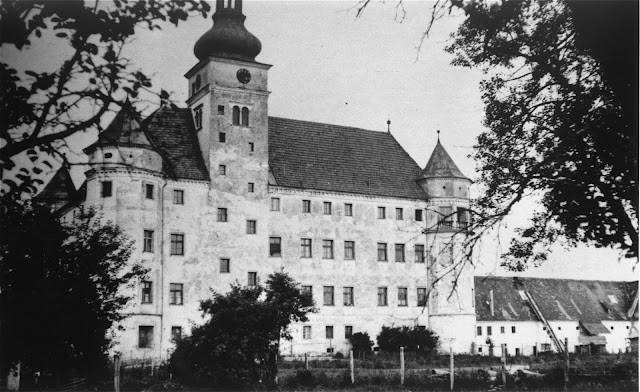5: The T-4 Program
The wartime atmosphere fostered new programs that would make large a contribution to the technology of the Final Solution. A number of these involved the quiet killing of mental patients and deformed children -- "useless eaters," in the Nazi vernacular -- usually with poison gas and lethal injections. The Fuhrer had personally taken the lead in this program in 1938 when he received a request from the father of a deformed child asking that the child be put to death. Hitler wrote a letter to the parents concurring in their request for the action. He asked his personal physician, Karl Brandt, to attend to the matter.
In early 1939, the government established the Reich Committee for Scientific Research of Hereditary and Severe Constitutional Diseases. Its function was to organize the killing of deformed and retarded children. Committee experts asked doctors, midwives and hospital administrators to notify them of eligible children. Then the committee established special children's centers in 21 hospitals to carry out the killings.
The work was done primarily by lethal injection, but Eglfing-Haar, near Munich, a Dr. Pfannmueller made a specialty of starving sick children to death. One visitor to Pfannmueller's hospital reported seeing 15 to 25 children, aged one to five, lying in cots. Pfannmueller explained: "Those creatures represent for me, as a National Socialist, only a burden to our nation. We do not kill by poison injections because foreign newspapers and certain gentlemen from Switzerland -- the Red Cross -- would get new material for for their propaganda. Our method is much simpler and more natural."
Then the doctor yanked one of the children from a cot and, displaying the child aloft, declared, "This one will last another two or three days." Pfannmueller explained to his visitor that his technique was not to withhold food suddenly but rather to impose a gradual reduction of rations.
Of greater scope that the children's program was the killing of the adult insane, established by the National Coordinating Agency for Therapeutic and Medical Establishments. The program was code-named T-4 for the agency's headquarters at 4 Tiergartenstrasse in Berlin. The first center was set up in Brandenburg in late 1939, and experiments were undertaken to find a killing method that would not alarm the victims and that later would permit officials to deceive the families of the victims as to the true cause of death. Hitler's physician, Brandt, reported to the Fuhrer on the gassing of four adult male patients with cyanide gas -- a rat killer known by the brand name Zyklon B -- and observed further experiments with it and, more often, carbon monoxide. Philipp Bouhler, head of Hitler's personal chancellery, was credited with suggesting that the gas chambers be disguised as shower rooms, complete with toilets.
Five additional centers were equipped along the lines of the one in Brandenburg. Their operation was deceptively simple. Patients judged incurably insane were sent to transit facilities. The Charitable Foundation for Institutional Care provided transportation to the killing center, and later notified the families in a form letter that their loved one had succumbed to heart failure or pneumonia and that the body had been cremated as a health measure.
Typically, attendants at the center dressed groups of 20 to 30 patients in paper smocks and ushered them into the gas chamber under the pretext that they needed to shower. Then the physician on duty gassed them. A conveyor belt removed the bodies.
Though the government tried to keep the T-4 program a secret -- officials did not want to undermine morale in wartime -- word drifted about with the smoke that rose from the crematoriums. School children living close to the Hadamar center near Limburg referred to the bus that brought in patients as the "murder box." Little children taunted friends, "You'll be sent to the baking oven." Young girls vowed they would never "bring children into the world so they can be put into a bottling machine," and old people pleaded with their families not to send them to the nursing home, for "after the feeble-minded have been finished off, the next useless eaters whose turn will come are the old people."
The Nazis produced a film to make the idea of euthanasia acceptable. The film told the story of a devoted husband who kills his terminally ill wife at her request in order to end her suffering. This distorted the T-4 program, but the film makers hoped that people would begin to think about executions as a form of racial mercy for the nation.
Though the film was something of a success at the box office, it was strongly opposed by Catholic and Lutheran bishops, who urged parishioners not to view it. And several bishops openly protested the T-4 killings. As public opposition mounted, Hitler reluctantly instructed Brandt to "stall" the program in August 1941, after some 90,000 patients had been killed. But by then, the gassing techniques used in the killing of mental patients were ready for more general applications.




Comments
Post a Comment